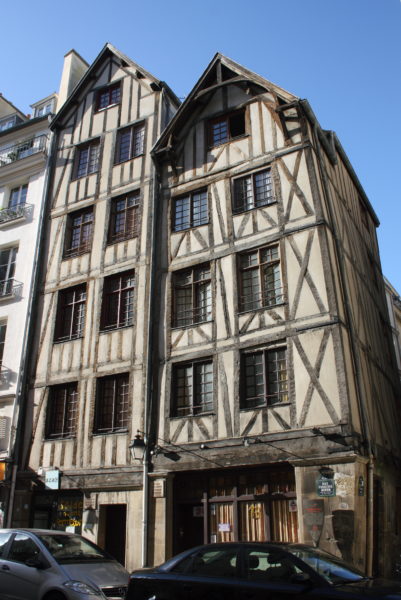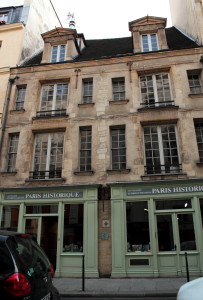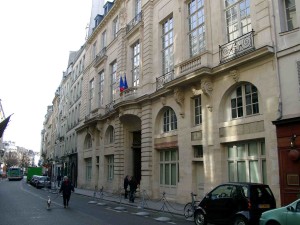Kate is one of those stories I couldn’t resist putting in the next book Where Did They Burn the Last Grand Master of the Knights Templar? A Walking Tour of Medieval Paris. While she lived in the 17th-century—more than 100 years after the end of the Middle Ages—Kate was in the right place at the right time.
Rue François Miron
I learned about Kate while researching one of the streets in the historical district: Rue François Miron.
If you start at the Place de la Bastille and walk due west, you’ll be following Rue Saint-Antoine. Just before the Métro St. Paul, the road splits: Rue Saint-Antoine becomes Rue de Rivoli—the northern split; and Rue François Miron—the southern split. Rue de Rivoli did not exist until Napoléon’s rule and then finished off in the mid-19th century when it was completed by Baron Haussmann.
For centuries Rue Saint-Antoine and its western extension, Rue François Miron, was the primary east-west route through the city. You would enter Paris from the east through the Porte Saint-Antoine next to the Bastille and then proceed west until you got to the city’s center near the Hôtel de Ville and Place de Grève. During the Middle Ages, this major street was called Rue du Cimetière Saint-Gervais.
-

11 & 13, rue François Miron. Photo by GFreihalter (2011). PD-CCA Share Alike 3.0 Unported. Wikimedia Commons. 11, rue François Miron: known as the Maison à Penseigne du Faucheur (the house with the sign of the reaper).
- 13, rue François Miron: known as the Maison à l’enseigne du Mouton (the house with the sign of the sheep).
The names of houses referred to hand-painted signs dating to the 13th-century. Such signs typically identified houses rather than house numbers. These 15th-century houses have undergone extensive renovation. Historians acknowledge the changes were made post-Middle Ages but they give you a sense of what a typical medieval house might have looked like.
-

Maison d’Ourscamp: 44, rue François Miron. Photo by Alessia Smaniotto (2011). PD-CCA Share Alike 3.0 Unported. Wikimedia Commons. 44, rue François Miron: This building is Maison d’Ourscamp, constructed in 1585. Today it houses the local preservation organization. The building’s foundations are from the original structure constructed in 1255. The 13th-century cellar still exists and if you’re nice to the folks inside, they might let you go down into the small hole in the floor that leads to the cellar.
-

Front of Hôtel de Beauvais. Photo by br (2007). PD-Author Permission. Wikimedia Commons. 68, rue François Miron: The former residence known as Hôtel de Beauvais. It is now used by a public agency and has limited access.
Catherine Bellier
Catherine Bellier (1614–1689), otherwise known as “One-eyed Kate,” was the lady’s maid for Queen Anne of Austria. Anne was the mother of the young French king, Louis XIV. Catherine, in her forties, taught the 16-year-old king the ways around a bed, and to show her appreciation, Queen Anne gave her the land upon which Catherine and her husband, Pierre de Beauvais, built the large Hôtel de Beauvais (68, rue François Miron). This marvelous mansion was built on the site of a former 13th-century townhouse used by visiting monks of the Cistercian Abbey of Challis.

On 26 August 1660, the 22-year-old king and his new bride, Marie-Thérèsa of Spain, entered the city and traveled down Rue Saint-Antoine and Rue François Miron—right past this building. Facing the building, you will see the original balcony directly above the entrance. The Queen Mother, One-eyed Kate, and Queen Henrietta of England (her husband, King Charles I, had his head cut off 11 years earlier) stood on this very balcony to watch Louis XIV and his procession stop in front to salute his mother before moving on. Take a close look at the stones used to build this mansion. They were left over from one of the Louvre’s construction periods.

One-eyed Kate was broke at the time of her death. Her son sold the Hôtel de Beauvais to pay her debts. A little over a hundred years later, the seven-year-old music prodigy, Mozart, stayed here. His second-floor room overlooked Rue François Miron.
Paris Streets
The history of Parisian streets is fascinating. From Roman times to Haussmann’s reconstruction (mid-19th century), the streets have changed names and direction. New streets have been constructed and old streets destroyed. Many streets provided Paris citizens with blockade positions and ammunition (e.g., cobblestones) during protests, revolutions, and foreign invasions.
I have yet to find a definitive and comprehensive history of Paris streets. Perhaps it is a topic for a future book? What do you think?
Someone Is Reading Our Blogs
I’d like to thank Kenn P. for his kind comments concerning our first series of walking tour books, Where Did They Put the Guillotine? Kenn purchased both volumes and wrote a very nice review on Amazon. His story about how his daughter got turned onto history after reading the books was very cool. You can read his comments on Amazon or as the testimonial on the back cover of the new book Where Did They Burn the Last Grand Master? A Walking Tour of Medieval Paris.
We need your help
Please tell your friends about our blog site and encourage them to visit and subscribe. Sandy and I are trying to increase our audience and we need your help through your friends and social media followers.
What’s New With Sandy and Stew?
We have worked with some extremely talented people to come up with our new logo. It was necessary to brand Stew Ross, the author as opposed to the corporate entity, Yooper Publications. I hope you like the Stew Ross Discovers™ logo:
We’ve also tried to refine our tag line to more accurately reflect our product:
WALKS THROUGH HISTORY
As part of this refreshing process, we will be working on our blog site to ensure it is updated, professional, easy to navigate, and contains relevant content.
We have a lot of stories and we’re looking forward to sharing these with you. Please continue to visit our blog site and perhaps you’d like to subscribe so that you don’t miss out on our blog posts, past and current.
Thank You
Sandy and I appreciate you visiting with us. We have some exciting things on the horizon and we’ll keep you updated as we go along.
Share This:
Follow Stew:
Find Stew’s books on Amazon and iBooks.
Please note that we do not and will not take compensation from individuals or companies mentioned or promoted in the blogs.
Walks Through History
Copyright © 2016 Stew Ross

Stew,
I was looking up one-eyed Kate and came across your post. In 1992/93. I lived in Paris working as a “jeune fille au pair” – a nanny to a family in the 18th arr.
The shortest version of my story is that My friend was friends with someone who had access to the property of Hotel de Beauvais while it was being renovated. I, along with about 25 others quietly slipped through the streets one night, through the carriage entrance (giant double doors in the image above) and down a ladder through the hole in the floor you mentioned, and proceeded to party in the caves of this historic structure. We weren’t even sure it had happened when we woke up the next day that my friend and I retraced our steps to find those carriage doors. There was an article posted in the window about the history, the renovation, and of course Kate. My only regret is that I didn’t have my camera to take a pic to prove it.